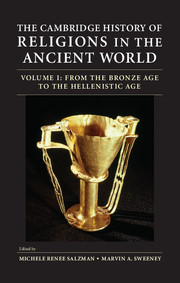Book contents
- Frontmatter
- Contents
- List of Figures and Maps
- List of Contributors
- List of Abbreviations
- Acknowledgments
- Introduction to Volumes I and II
- Introduction to Volume I
- Part I Mesopotamia and the Near East
- Part II Egypt and North Africa
- Part III Greece and the Eastern Mediterranean
- Part IV The Western Mediterranean and Europe
- Suggestions for Further Reading
- General Index
- Index of Citations
- Frontmatter
- Contents
- List of Figures and Maps
- List of Contributors
- List of Abbreviations
- Introduction to Volume II
- Part I Iran and the Near East
- Part II Egypt and North Africa
- Part III Greece and Asia Minor
- Part IV Italy, Roman Gaul, and Spain
- 14 Religion in Rome and Italy from the Late Republic through Late Antiquity
- 15 Judaism in Italy and the West
- 16 Christianity in Italy
- 17 Religions and Cities in Roman Gaul (First to Fourth Centuries CE)
- 18 Christianity in Gaul
- 19 Religions of Roman Spain
- Suggestions for Further Reading
- General Index
- Index of Citations
- References
14 - Religion in Rome and Italy from the Late Republic through Late Antiquity
from Part IV - Italy, Roman Gaul, and Spain
Published online by Cambridge University Press: 05 October 2013
- Frontmatter
- Contents
- List of Figures and Maps
- List of Contributors
- List of Abbreviations
- Acknowledgments
- Introduction to Volumes I and II
- Introduction to Volume I
- Part I Mesopotamia and the Near East
- Part II Egypt and North Africa
- Part III Greece and the Eastern Mediterranean
- Part IV The Western Mediterranean and Europe
- Suggestions for Further Reading
- General Index
- Index of Citations
- Frontmatter
- Contents
- List of Figures and Maps
- List of Contributors
- List of Abbreviations
- Introduction to Volume II
- Part I Iran and the Near East
- Part II Egypt and North Africa
- Part III Greece and Asia Minor
- Part IV Italy, Roman Gaul, and Spain
- 14 Religion in Rome and Italy from the Late Republic through Late Antiquity
- 15 Judaism in Italy and the West
- 16 Christianity in Italy
- 17 Religions and Cities in Roman Gaul (First to Fourth Centuries CE)
- 18 Christianity in Gaul
- 19 Religions of Roman Spain
- Suggestions for Further Reading
- General Index
- Index of Citations
- References
Summary
In the year 384 CE, the Roman senator Quintus Aurelius Symmachus sent this letter to a colleague:
I am intensely distressed, because, despite numerous sacrifices, and these often repeated by each of the authorities, the prodigy of Spoletum has not yet been expiated in the public name. For the eighth sacrificial victim scarcely appeased Jove, and for the eleventh time honor was paid to Public Fortune with multiple sacrificial victims in vain. You know now where we are. The decision now is to call the colleagues to a meeting. I will make sure you know if the divine remedies make any progress. Farewell.
We do not know the nature of the Spoletum prodigy, but communal fears aroused by natural or manmade disasters, such as earthquakes, drought, and military defeats, were the most frequent reasons for the kind of ritual response mentioned by Symmachus. Following traditional practice, Symmachus refers the matter to the colleagues in the senate who, if they deemed it significant, would then consult with the priestly augures or the quindecimviri sacris faciundis to determine the appropriate actions to be undertaken by the priests, magistrates, or people as a whole. It is striking that Symmachus’s concern as well as the mechanisms to address prodigies had remained in place in Rome at least into the late fourth century, some seventy years after the first Christian emperor, Constantine, claimed the city as his own.
- Type
- Chapter
- Information
- The Cambridge History of Religions in the Ancient World , pp. 371 - 397Publisher: Cambridge University PressPrint publication year: 2013
References
- 1
- Cited by



